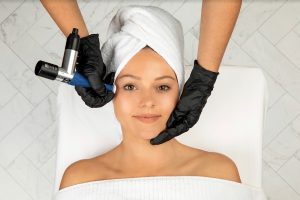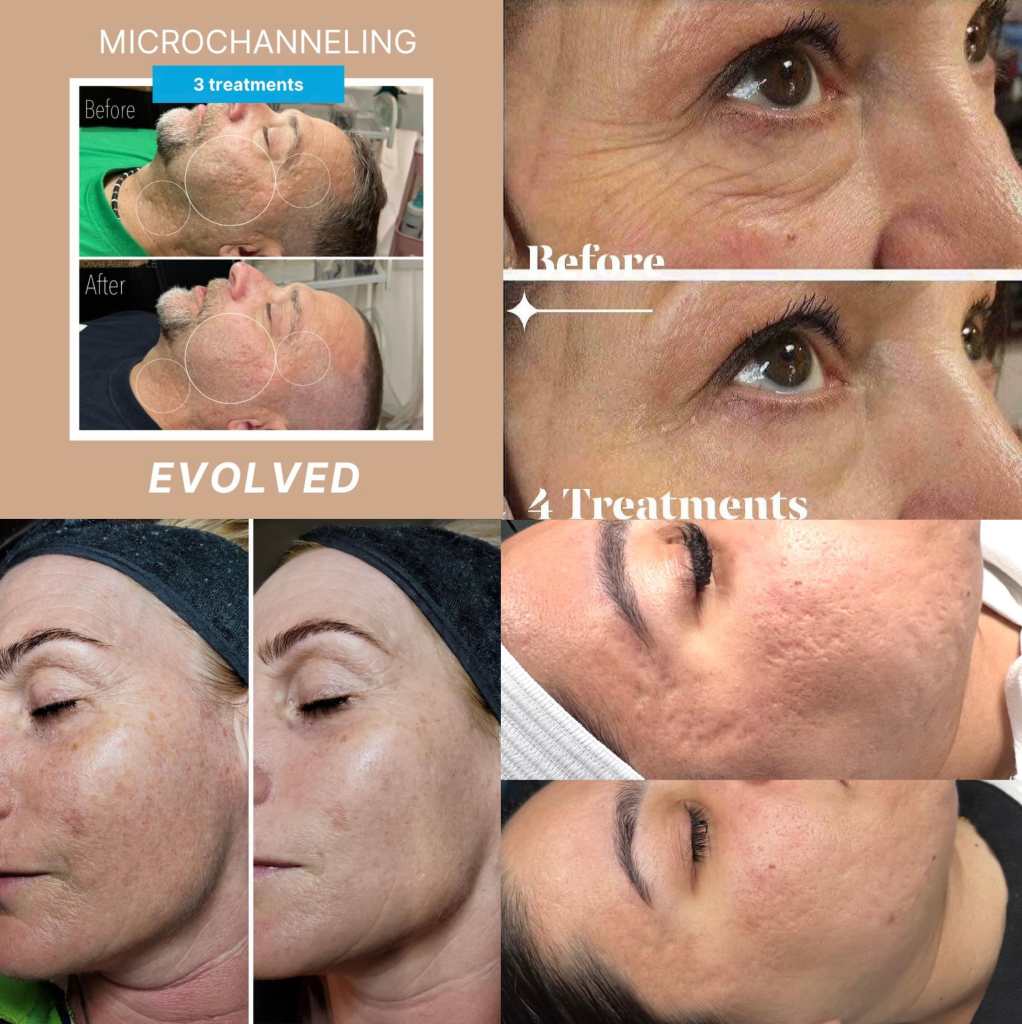Microneedling vs. Microchanneling:
Which Skin Treatment is Right for You?
 When it comes to rejuvenating your skin and combating the signs of aging, collagen induction therapy has become increasingly popular. Two techniques that are frequently discussed in this context are microneedling and microchanneling. While both aim to stimulate collagen production and improve skin texture, they have some key differences that might make one more suitable for you than the other. In this detailed comparison, we’ll delve into the pros and cons of both microneedling and microchanneling, including the mention of the Procell microchanneling tool, and describe how the procedure is done in a stamping rather than a gliding approach using growth factors, which contributes to minimal downtime.
When it comes to rejuvenating your skin and combating the signs of aging, collagen induction therapy has become increasingly popular. Two techniques that are frequently discussed in this context are microneedling and microchanneling. While both aim to stimulate collagen production and improve skin texture, they have some key differences that might make one more suitable for you than the other. In this detailed comparison, we’ll delve into the pros and cons of both microneedling and microchanneling, including the mention of the Procell microchanneling tool, and describe how the procedure is done in a stamping rather than a gliding approach using growth factors, which contributes to minimal downtime.
 What is microneedling?
What is microneedling?
Let’s explore microneedling, a form of collagen induction therapy frequently employed by dermatologists or trained skin care professionals working with a medical director to address various skin concerns such as acne, wrinkles, scarring, skin pigmentation issues, and alopecia. This procedure entails the use of small, sterilized needles to create minute punctures in the skin, inducing micro-injuries also called micro-channels. These tiny wounds stimulate the natural production of elastin and collagen by your body, ultimately resulting in skin healing and a rejuvenated appearance characterized by enhanced plumpness and a more youthful look.
Microneedling: Transformation from Start to Finish
If you’re grappling with skin concerns such as pigmentation issues, wrinkles, or acne scarring, microneedling stands out as an exceptional treatment option when paired with the appropriate targeted serum for the specific concern. The procedure itself boasts a strong safety profile, with minimal associated risks. Typically, microneedling sessions last approximately 30-60 minutes, the duration dependent on the specific treatment area. To maximize the impressive microneedling before-and-after results, it’s advisable to undergo a series of treatments, usually a minimum of four sessions, each spaced one month apart.
The exact number of required sessions hinges on the specific issue being addressed and your desired outcome. It’s worth noting that the procedure entails minimal to virtually no risks, provided you diligently adhere to the aftercare regimen recommended by the aesthetician. While you’ll notice immediate improvements, the full spectrum of results becomes most apparent around six weeks after your microneedling journey begins.
Exploring Microchanneling: The Next-Generation Skin Rejuvenation
 Now, transitioning from our discussion on microneedling, let’s delve into the focal point of our conversation: microchanneling. This innovative approach represents an evolutionary leap beyond traditional microneedling, catering to both facial and body applications. Microchanneling is often hailed as the advanced successor to microneedling, sharing fundamental similarities while offering distinct advantages.
Now, transitioning from our discussion on microneedling, let’s delve into the focal point of our conversation: microchanneling. This innovative approach represents an evolutionary leap beyond traditional microneedling, catering to both facial and body applications. Microchanneling is often hailed as the advanced successor to microneedling, sharing fundamental similarities while offering distinct advantages.
Much like microneedling, microchanneling is a non-invasive skin rejuvenation procedure designed to boost collagen and elastin production, resulting in a more youthful and plump complexion. However, the key differentiator lies in the method. In microchanneling, very fine wire-based filaments that are a specific depth delicately create controlled micro-injuries on the outermost layer of the skin. During this process, a serum enriched with stem cells is introduced through these channels, supplying vital nutrients to skin cells and expediting the repair and regeneration process. This approach is notably gentler and less invasive, making it a preferred choice for facial treatments when compared to traditional microneedling. The disposable tip on the microchanneling device does not allow any back flow of blood or contaminants to get trapped back up in the device because of the way the device is designed which is safer.
Who Is a Candidate for Microchanneling?
Microchanneling treatments are minimally invasive and safe for all skin types and different color skin tones.
You are an ideal candidate for microchanneling if you have:
- Hyperpigmentation
- Sunspots
- Aging
- Wrinkles
- Uneven skin texture
- Traumatic scars or stretch marks
- Acne scars
- Hair loss
- Moderate skin laxity
You are not a candidate for microchanneling if you:
- Are pregnant or nursing
- Have eczema or rash on the treatment areas
- Have an infection (bacterial, viral, or fungal)
- Suffer from heart diseases
- Have open wounds or keloid scars
- Are allergic to stainless steel
- Have an active inflammatory skin condition
- Have diabetes or bleeding disorders
Advantages of Microchanneling
- Enhanced Skin Texture
Many individuals contend with issues such as uneven skin texture, decreased elasticity, and redness, whether on their entire complexion or specific areas. Microchanneling offers a solution by stimulating the production of reparative cells within the body. The infusion of a growth factor serum during the procedure expedites this process and provides the essential nutrients necessary to promote smoother skin.
- Heightened Hydration
Microchanneling significantly amplifies skin’s absorption capacity, increasing it by up to 300%. This means any topical serums or skincare products used penetrate deeply into the skin, delivering a concentrated dose of growth factors and nutrients to combat signs of aging like fine lines and wrinkles. For optimal results, consider treatments like the Procell Microchanneling Facial, which combines Exosomes (growth factors) with microchanneling to harness three times as many growth factors as PRP for remarkable improvements in skin youthfulness.
- Versatile Solutions for Multiple Concerns
Microchanneling’s versatility extends beyond facial applications. It serves as an effective treatment for various skin concerns, including acne scarring, hyperpigmentation, alopecia, and stretch marks. Its applicability isn’t confined solely to the face; it can be administered on hands, neck, and other body regions.
- Scar and Stretchmark Reduction Therapy
Acne scarring poses a common challenge, particularly for individuals with sensitive skin. Microchanneling presents a viable option for minimizing or completely eliminating scars over a series of treatment sessions while enhancing skin tone and texture. If you’re dealing with active acne, consulting with a medical aesthetician can help determine if microchanneling is the right choice for you.
- Low Risk and Minimal Downtime
When administered by a skilled professional aesthetician, microchanneling carries minimal to negligible risks. Patients may experience temporary redness ,mild swelling, sometimes minor bruising typically resolving within a few hours. Lower risks translate to shorter downtime.
Microchanneling: Precautions and Aftercare for Optimal Results
Given that microchanneling is a cosmetic procedure, it’s crucial to observe specific guidelines to ensure a smooth treatment process, minimize potential side effects, and achieve the best possible outcomes. Here, we outline both pre-treatment and post-treatment care for microchanneling.
Before Your Microchanneling Session
- Refrain from using topical agents like exfoliants and antibiotics (e.g., retinol) that can heighten skin sensitivity for at least 6 to 7 days before your scheduled treatment.
- Avoid consuming alcohol or caffeine in the 48 hours leading up to the procedure.
- Steer clear of waxing or threading any treatment areas for at least one week prior to your microchanneling session.
- Do not take anti-inflammatory or blood thinner medications that may interfere with the procedure.
- Ensure your face is free from any tan or sunburn.
After Your Microchanneling Session
- Exercise caution regarding sun exposure and direct sunlight for a duration of two weeks following the treatment. The skin is particularly sensitive within the first 24 hours, making it advisable to avoid outdoor activities during this initial period.
- Make use of freshly laundered bed sheets and pillowcases post-treatment, a practice that’s beneficial regardless of whether you’ve undergone microchanneling.
- Refrain from using medications or ice to address inflammation; instead, allow it to subside naturally over time.
- If you experience discomfort, consider employing a growth factor postcard treatment kit or moisturizers recommended by your professional aesthetician.
- Avoid applying sunscreen on the day immediately following the procedure.
- Mild side effects, such as redness and puffiness, should generally dissipate within the initial 24 hours. It any bruising presents, that usually alleviates within a week to 14 days.
Microneedling
Pros:
- Versatile: Microneedling is a versatile treatment that can address various skin concerns, including fine lines, wrinkles, acne scars, enlarged pores, and stretch marks.
- Proven Efficacy: Microneedling has a solid track record of effectiveness in promoting collagen production and skin rejuvenation.
- Minimal Downtime: The downtime associated with microneedling is relatively short. You may experience redness and mild swelling for a day or two, but most people can resume normal activities quickly.
- Cost-Effective: Compared to some other skin rejuvenation procedures, microneedling is often more cost-effective.
Cons:
- Discomfort: Microneedling can be uncomfortable, especially if not performed with numbing cream or in sensitive areas.
- Multiple Sessions: Achieving optimal results typically requires a series of sessions spaced a few weeks apart, which may not be convenient for everyone.
- Risk of Infection: Improperly sterilized equipment or poor aftercare can increase the risk of infection.
Microchanneling
Pros:
- Precise Delivery of Serums: Microchanneling involves creating tiny channels in the skin that allow for the precise delivery of serums and growth factors. This can enhance the effectiveness of topical treatments.
- Minimal Discomfort: Microchanneling tends to be less painful than microneedling due to its gentle, stamping motion.
- Shorter Downtime: Recovery time is usually shorter with microchanneling, with minimal redness and swelling that typically subside within a day.
Cons:
- Limited Research: While microchanneling is gaining popularity, there is less scientific research available to confirm its long-term efficacy compared to microneedling.
- Cost: Microchanneling treatments often come at a higher price point, mainly due to the use of specialized serums and devices.
- Maintenance Required: Some individuals may need more frequent microchanneling sessions to maintain results.
Before and After Photos:
 Which Is Right for You?
Which Is Right for You?
Ultimately, the choice between microneedling and microchanneling depends on your specific skin concerns, pain tolerance, budget, and preference for treatment. If you’re looking for a versatile and well-established collagen induction therapy with proven results, microneedling may be the better option. On the other hand, if you prioritize minimal discomfort and the targeted delivery of serums, microchanneling could be your preference.
Before making a decision, consult with a qualified skincare professional who can assess your skin, discuss your goals, and recommend the most suitable treatment plan. Keep in mind that both microneedling and microchanneling can be effective tools in your quest for youthful, radiant skin, and your choice should align with your individual needs and expectations.
Book an advanced skincare consultation at Anita’s Skincare Clinic in Katy, Texas to find out if collagen induction therapy either microneedling or microchanneling will be suitable for your skin concern. To learn more about collagen induction therapies, please visit our website.

